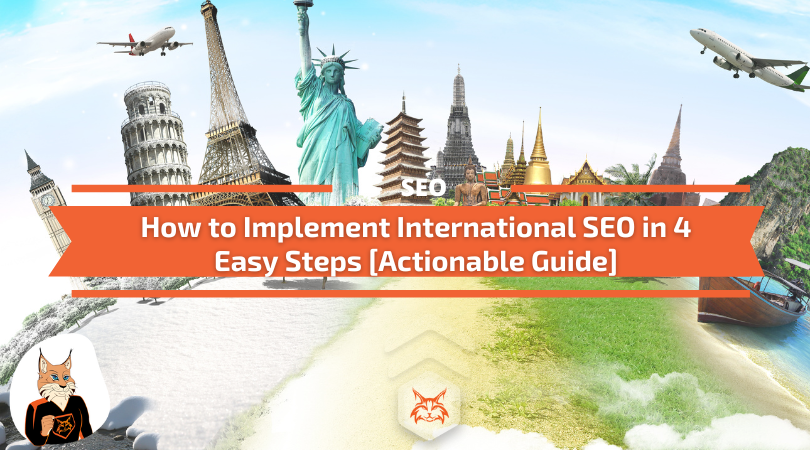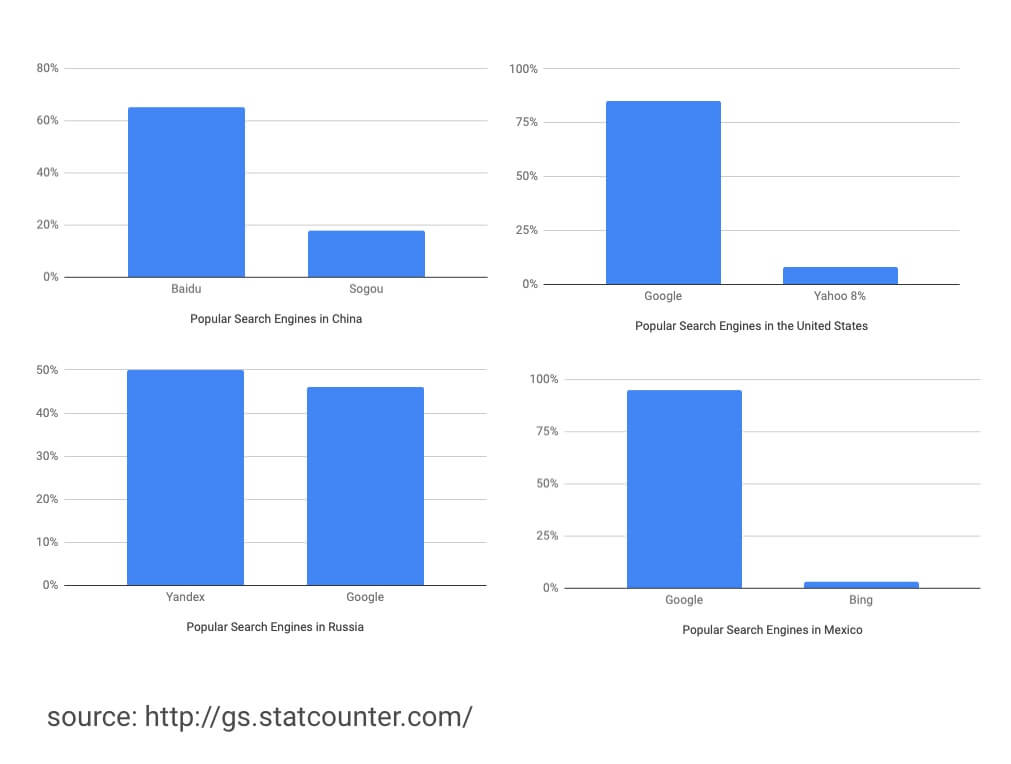Do you serve customers in more than one country? Do any of your customer segments speak different languages? International SEO should be on your radar if you answered yes to either of those questions. Applying best practices to your website can attract more traffic, grow your global presence, and serve your customers better with these international SEO tips.
What Is International SEO?
International SEO is optimizing your search presence for people in different countries or who speak different languages. You can target content to your users worldwide using geo-targeting, hreflang tags, and other localization signals.
Using geo-targeting, hreflang tags, and other #SEO localization signals, you can target content to your users around the world.Click to tweetHow does international SEO work?
Google tries to match search results to the language and location of the searcher. Special signals you add on your website help Google or other search engines know when your site has content suitable for someone in a particular country or is searching in a specific language.
Here are four essential steps to implementing international SEO on your site and making it a part of your digital marketing strategy for global audiences.
Step 1: Determine What International Content You Will Provide
Do you want to optimize search results based on language, geo-targeting, or both?
Some sites focus on language, like Facebook’s home page, which allows users to select their language. Air Canada uses a pop-up to let some users choose their language and country, sending them to a specific URL based on their selection.

You can also target content by country AND language choice, like eBay, which makes separate marketplaces available in the local languages of 23 different countries. British clothing retailer Boden customizes content by country, with independent websites for customers in the United Kingdom, the United States, Germany, France, Australia, and more.
As you can see, the spectrum of content ranges from simply translating your English material into more languages to creating fully customized experiences as eBay does. Once you know what international content you will provide, you must decide how to structure your website for international SEO.
Not sure which countries to optimize for international SEO? One input to consider is identifying countries generating a lot of links or traffic to your site. Our friends at Linguise have a to-the-point guide on choosing your translation languages with analytics and market data. Alternatively, you can use Google Analytics to check what countries drive traffic to your site. If you see a lot of traffic from a country you haven’t optimized your website, you might consider optimizing for those countries. You can also use the Language report in Google Analytics to see your users’ language.
Step 2: Set Up an International SEO-Friendly URL Structure
Your URL structure helps Google figure out which of your pages to show searchers in different countries. This is part of geo-targeting, which focuses on location. To further target language, we’ll also show you how to use the hreflang tag in a moment.
Most businesses either set up a new website for each target country or add a subdirectory structure to their existing website. Your approach will depend mainly on the resources you can dedicate to creating and maintaining it. Let’s discuss the pros and cons of each URL structure for international SEO.
A Subdirectory for Each Country on Your Main Website
To set up a subdirectory structure, create a folder on your website for each target country labeled with that country’s two-letter ISO code. For example, to signal content targeted to people in Spain, your subdirectory would look like this: website.com/es.
Pros of using subdirectories: A subdirectory structure is easy to set up and maintain. Adding subdirectories to your website is straightforward and cost-effective. It only requires one website domain, and the authority you build up for that domain applies sitewide. Some think this option has become the clear choice for nearly any business.
Cons: The international SEO signal for a subdirectory is weaker than if you were to set up a website entirely dedicated to a country.
Best for: A business or organization that wants to serve companies across multiple countries and keep its communications on one website.
Examples of companies that use subdirectories for their international websites:
- Apple (apple.com/uk/ for users in the United Kingdom)
- Nike (nike.com/za/ for users in South Africa)
- Spotify (spotify.com/ar/ for users in Argentina)
A Separate Website for Each Country
Some companies set up separate websites for visitors from each targeted country. This is called a local country code top-level domain (ccTLD). A ccTLD for your users in Spain would look like this: website.es
Some codes are “open,” meaning they can be registered for uses other than representing the country. For example, .co is the official country code for Columbia, but you probably know it more for its association with “company” or “corporation.” Some ISO codes have also been adopted for use with cities: .to is used for Toronto and Tokyo in addition to Tonga. ICANNWiki maintains a list of top-level domains for country code.
Pros of using ccTLDs: Dedicating a separate domain using a country code offers search engines the most powerful country signal for international SEO. It also tells website visitors that your brand is dedicated to its presence in that country.
Cons: Maintaining separate websites for different countries can be expensive. Regarding international SEO, you’ll also have to build authority for each website separately.
Best for: Large businesses with deep resources. Because maintaining multiple websites is so expensive, it’s not usually a good choice for smaller companies. An exception is if you are targeting China. Without the .cn top-level domain, it can be challenging for websites to rank on Baidu, China’s most prominent search engine.
Examples of companies that use separate websites (ccTLD) for different countries:
- Sony (corporate website for China: sony.com.cn/)
- Disney (shopping site for France: shopdisney.fr/)
- McDonald’s (in Serbia: mcdonalds.rs/)
Subdomains Not a Popular Choice for International SEO
In theory, you also have a third choice: You could set up a subdomain on your website for each country. However, the disadvantages generally outweigh the advantages.
The international SEO signal is weaker than a dedicated country domain for a subdomain. It may also be more challenging to take advantage of the authority of the main domain for subdomains than for subdirectories. (While Google treats subdomains and subdirectories equally regarding ranking sites, SEO experts debate whether this holds. Many believe that pages on a subdomain don’t reap the benefits of the root domain and are seen as separate domains by Google or that the subdomain may dilute the root domain’s authority.)
If the best URL structure seems unclear for your business, look at competitors in your target country.
One way to gain international competitive intelligence is to run a site comparison for your top 10 competitors. If your main competitors are getting a ton of traffic from one of your target countries, you can check out their international SEO tactics for that country.
Ensure you have the proper country code before setting up your URL structure. And keep in mind that regardless of your choices, Google may occasionally show the wrong content to searchers. The hreflang tag can provide additional signals to help Google determine when to show what.
Step 3: Use Hreflang Tags for Language Targeting
Hreflang tags are small snippets of code used on websites with content in multiple languages. They help search engines match up the correct language with the searcher. For example, French speakers will see your French content instead of your English or Italian content.
How does Google know which language a user prefers?
The terms the searcher enters are significant clues, of course. But Google also looks at data such as the user’s settings, search history, location, and Google domain (Google.com vs. Google.de, for example).
The hreflang tag is proper when providing translations of your content in subdirectories or subdomains. While search engines can usually detect the language on a page without hreflang tags, the tags help prevent your different page versions from competing in search results. Hreflang tags are unnecessary when using separate domains (ccTLDs) because of the signal from the country code. However, some people use them because the hreflang tag can strengthen the location signal.
If you decide to use hreflang tags, follow the guidelines below. WordPress users: You may be able to use a translation plugin to manage your translations and your hreflang tags. If you don’t intend to use a translation plugin, check this guide to install a simple href tag management plugin.
How to Use Hreflang Tags
International content is often translated into English-language pages. That means you end up with a different version of the same page and a similar URL for each language, which means these versions could compete in search results. A hreflang tag accompanies each URL version across your website, helping to avoid this competition.
The hreflang tag can include two components:
- Mandatory: The language code (using ISO ISO 639-1 codes)
- Optional: A country code (using ISO 3166-1 alpha-2 country codes)
The format for a hreflang tag is hreflang= “languagecode-countrycode.”
Hreflang Tags Example
By pulling up the source code for Apple, you can see its hreflang attributes:

Each tag specifies the country and language of users and is placed after the URL. “en-US” refers to English speakers in the United States, “ar-AE” is for Arabic speakers in the United Arab Emirates, “en-AE” is for English speakers in the United Arab Emirates, and so on.
Suppose your main page automatically redirects users based on their location or asks them to select the language for the page (like the Air Canada example above). In that case, you may also need an x-default hreflang tag. Google explains that this attribute value “signals to our algorithms that this page doesn’t target any specific language or locale and is the default page when no other page is better suited.”
You have three choices for where to use hreflang tags:
- In the source code of the header on each page (most popular)
- In the HTTP header on every page
- In your sitemap
Choose the easiest to maintain, but use your hreflang tags in only one of these places on your site.
Step 4: Support International SEO with More Signals
Localizing content goes beyond the technical choices outlined above. International SEO can benefit from a well-rounded view of the users of a target country or language.
Consider Search Engine Preferences
At 92% worldwide, Google holds the largest share of Internet searches. But this isn’t the case in every country. In China, for example, Baidu captures 65% of the market segment share, and Yandex is popular in Russian-speaking countries.
While there will be many similarities among search engines, you will want to explore more deeply how to optimize your international SEO efforts for Baidu or Yandex, for example, if China or Eastern European countries are part of your global presence.
Target Content to Fit Device Preferences
People in different countries prefer to access the Internet in various ways. Making your content easily consumable via the most popular devices can help with usability and impact SEO. Knowing how people access search enables you to understand where to put your efforts to optimize their experience.
Consider Additional Local Signals
Additional geo-targeting signals can work in your favor. Consider using the following strategies to signal the country or language of your users:
- Include links to your presence on popular local social media outlets.
- Display prices in local currencies.
- Include location data such as address and phone number for your regional offices.
Because your international SEO efforts aim to serve your customers well, it will also be worthwhile to understand local preferences for colors, design aesthetics, content organization, and other cultural factors. Whenever possible, ensure your translated content is prepared by a native speaker and reviewed by members of the intended audience.
Get Started with International SEO
International SEO starts with understanding how to serve your customers best and then making efforts to customize your content and search experience to their needs.
Using the steps above, you can start with international SEO to optimize your website for your audiences in different countries or other languages.
At Competico, an international SEO agency, we can help you develop and implement a global SEO strategy to rank in your target countries and territories. Check our ongoing SEO plans.








![How to do Digital Marketing For International Audiences [Complete & Actionable Guide]](https://competico.com/wp-content/uploads/2022/06/How-to-do-Digital-Marketing-For-International-Audiences-Complete-Actionable-Guide-300x167.png)


Great article, Thank you!
nice points covered. thans fr sharing these…
“International SEO” is one of the most effective ways to leverage organic search to reach target audiences in different countries.